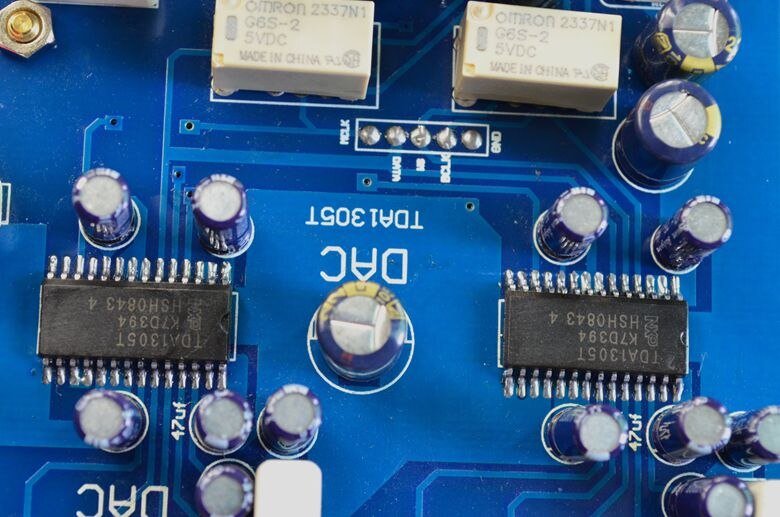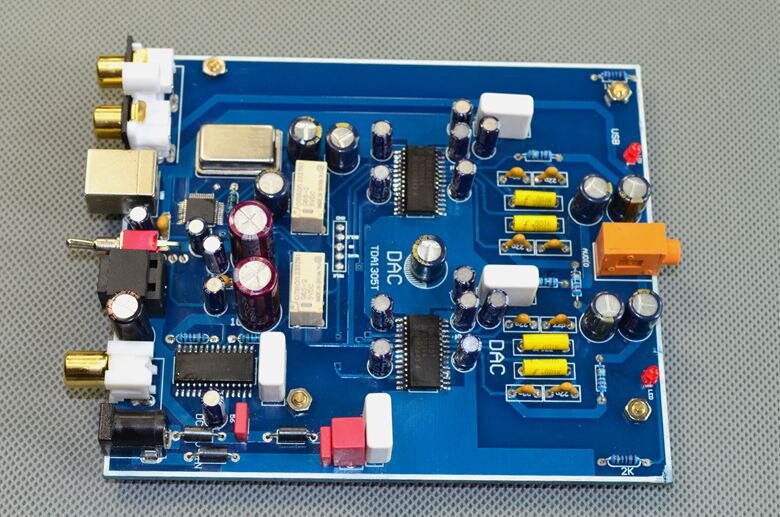After 30 years its a bit late to start doubting the datasheet.So the MCK varies based on received sample freq. ??? Anyone know?
Doing some further experimenting with the Chinese dual-tda1305T board, and seem to running into a snag.
Today's project is to use a dedicated USB-to-I2S board, like this (I have used the above converter in other projects, so I know it work)
... and connect it to the I2S and mclk input thru-hole via pads (see photos).
It seem the Chinese kit developer put them in so hobbyists can tinker.


Here's my specific kit board with Molex connectors for I2S/mclk and one for GND ...

The image above shows I am feeding an independent 5v line to DACs. The Chinese board's internal USB and Receiver get their own power. This arrangement works well.
HOWEVER, now using this ...

...and plugging in USB from my PC with new USB-I2S converter produces NO sound output.
I did disconnect power to Chinese board's internal USB and Receiver chips their own power via the default 5v input jack -- I just unplugged that as I did not want to create any strange ground loops.
So why doesn't the external dedicated USB-to-I2S board work with the Chinese 1305 kit?
Today's project is to use a dedicated USB-to-I2S board, like this (I have used the above converter in other projects, so I know it work)
... and connect it to the I2S and mclk input thru-hole via pads (see photos).
It seem the Chinese kit developer put them in so hobbyists can tinker.


Here's my specific kit board with Molex connectors for I2S/mclk and one for GND ...

The image above shows I am feeding an independent 5v line to DACs. The Chinese board's internal USB and Receiver get their own power. This arrangement works well.
HOWEVER, now using this ...

...and plugging in USB from my PC with new USB-I2S converter produces NO sound output.
I did disconnect power to Chinese board's internal USB and Receiver chips their own power via the default 5v input jack -- I just unplugged that as I did not want to create any strange ground loops.
So why doesn't the external dedicated USB-to-I2S board work with the Chinese 1305 kit?
Last edited:
Could it be the MCLK ? In another sucessful/working application of that USB-I2S converter -- a CD player with and 8-pin dac (TDA1543) -- I just connected the three I2S pins and GND. There is no MCLK for the TDA1543. Not sure if/whey the 1305 requires a MCLK?
My PC is Linux. I can see both devices as when they are plugged in using the lsusb command:
philipsmarantz@philipsmarantz:~$ lsusb
XMOS Ltd is the external USB-I2S device; CM108 is the native USB device.Bus 002 Device 002: ID 174c:55aa ASMedia Technology Inc. Name: ASM1051E SATA 6Gb/s bridge, ASM1053E SATA 6Gb/s bridge, ASM1153 SATA 3Gb/s bridge, ASM1153E SATA 6Gb/s bridge
Bus 002 Device 001: ID 1d6b:0003 Linux Foundation 3.0 root hub
Bus 001 Device 003: ID 046d:c077 Logitech, Inc. M105 Optical Mouse
Bus 001 Device 005: ID 8087:0aaa Intel Corp.
Bus 001 Device 017: ID 20b1:0008 XMOS Ltd XMOS Audio
Bus 001 Device 002: ID 0928:0002 PLX Technology, Inc. (formerly Oxford Semiconductor, Ltd) OXSEMI Mass Storage
Bus 001 Device 001: ID 1d6b:0002 Linux Foundation 2.0 root hub
philipsmarantz@philipsmarantz:~$ lsusb
Bus 002 Device 002: ID 174c:55aa ASMedia Technology Inc. Name: ASM1051E SATA 6Gb/s bridge, ASM1053E SATA 6Gb/s bridge, ASM1153 SATA 3Gb/s bridge, ASM1153E SATA 6Gb/s bridge
Bus 002 Device 001: ID 1d6b:0003 Linux Foundation 3.0 root hub
Bus 001 Device 018: ID 0d8c:013c C-Media Electronics, Inc. CM108 Audio Controller
Bus 001 Device 003: ID 046d:c077 Logitech, Inc. M105 Optical Mouse
Bus 001 Device 005: ID 8087:0aaa Intel Corp.
Bus 001 Device 002: ID 0928:0002 PLX Technology, Inc. (formerly Oxford Semiconductor, Ltd) OXSEMI Mass Storage
Bus 001 Device 001: ID 1d6b:0002 Linux Foundation 2.0 root hub
Not my area of expertise.
Try on a Windows computer or another flavor of Linux, those have their issues also.
Try on a Windows computer or another flavor of Linux, those have their issues also.
It's not a Linux / Win issue. I just put the USB-I2S adapter back into it native habitat -- an old Philips CDP, tapping just the dac chip's I2S lines plus gnd -- and we have music again. The USB cable is connected to the same Linux PC.


So the Chinese dual tda1305 kit board and the USB-I2S adapter are not "handshaking". ???????????


So the Chinese dual tda1305 kit board and the USB-I2S adapter are not "handshaking". ???????????
On the Chinese 1305 board, Pins 7,8 are grounded (Datasheet, pg 6). So we have two-decade (20-bit) 256f s operation in situ. I have no clue what USB-I2S adapter is spitting out (384fs ???) .Two decades on and the comedy value hasn't dropped a bit.
in situ is the magic word. Not going to cut traces, or lift pins.
I assume the USB-I2S adapter's firmware can't be hacked?
Alas electronics doesn't care much for magic. You play by its rules or not at all. If you've read page 6 then it is clear that 256Fs sysclk is required which is just as well as the CS8412 only does 256Fs. A real amanero can be modified to produce 256Fs but unless there is an option to isolate the dacs from the CS8412 you won't get far without some mods.
I assume that "256Fs" is related to f_ws (word select input freq)-- yes? -- because the old CDP dac (see photos), the one that works with the USB-I2S adapter, notes in its DS:rfbrw:
Alas electronics doesn't care much for magic. You play by its rules or not at all. If you've read page 6 then it is clear that 256Fs sysclk is required which is just as well as the CS8412 only does 256Fs. A real amanero can be modified to produce 256Fs but unless there is an option to isolate the dacs from the CS8412 you won't get far without some mods.
f_WS, word select input frequency, 384 kHz (max).
In any case, a little sorcery might work:

Last edited:
Unless what the 1305 datasheet (page 6/7) notes about the "Data Clock: Number of clock pulses within half an audio sample." is going to get in the way.Note that MCK for the USB-I2S adapter is an integer 2x that of the Chinese 1305 kit.
I might have a few divide-by-two boards lying around.
Hmmm ...
How about simply feeding the tda1305 SYSCLKI, pin 12, system clock input (i.e., MCK) just this:Alas electronics doesn't care much for magic. You play by its rules or not at all. If you've read page 6 then it is clear that 256Fs sysclk is required which is just as well as the CS8412 only does 256Fs. A real amanero can be modified to produce 256Fs but unless there is an option to isolate the dacs from the CS8412 you won't get far without some mods.

Will that be the rabbit out of the hat?
Whatever approach you take is going to be undone by the presence of the CS8412. It has to be isolated for any external signal input to work.
- Home
- Source & Line
- Digital Source
- Looking for NAIM CD5 and/or CD 3.5 CD player schematics








